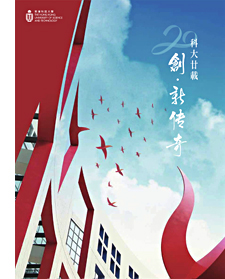|
 Planet Earth is our home. It was our parents' and grandparents' home and it will be home to our children and grandchildren. We are responsible for looking after this shared home of ours, and we all need to contribute to building a sustainable future by conserving its limited natural resources for the next generation. Universities can play a pivotal role in conserving these resources and promoting wise consumption. HKUST is committed to conserving these resources in a number of ways. Planet Earth is our home. It was our parents' and grandparents' home and it will be home to our children and grandchildren. We are responsible for looking after this shared home of ours, and we all need to contribute to building a sustainable future by conserving its limited natural resources for the next generation. Universities can play a pivotal role in conserving these resources and promoting wise consumption. HKUST is committed to conserving these resources in a number of ways.
Green Publishing
The Publishing Technology Centre (PTC) implements the following ongoing resource conservation measures:
- All printing plates and toner cartridges are recycled after use
- Only recycled and FSC paper are recommended to users
- Only soya bean ink and eco-friendly chemicals are used in the Printshop.
In 2012, the PTC also spearheaded a number of green initiatives:
|
|
|
-
To further reduce printing on campus, the PTC developed the " HKUST eBookshelf", promoting e-publishing in order to reach a wider audience using less printing.
-
As with the English version of the HKUST 20th anniversary book, the Chinese edition of the book, which was published in 2012, was also carbon neutralized.
|
 |
Green Purchasing
In addition to the existing green measures, in 2012 the Purchasing Office made it explicitly known to users that "Green Practices" were one of the key determining factors in the tender evaluation process. The "Green Contributions" of tenders are assigned a certain percentage in the tender process. The Purchasing Office aims to implement other green measures in the future.
Information System Services
Over the past year, the University continued its efforts to leverage information system capabilities to help streamline operations. In the course of doing so, we not only improved efficiencies but also made tangible contributions to green efforts. Below are some notable examples:
 The Electronic Procurement (eProc) System moved from the pilot or trial use by selected departments to full implementation throughout the University. Using workflow technology, the system enables the electronic preparation and submission of requisitions. Budget checking and approval are performed online. Valid requisitions which have cleared the tender/requisition process then move on to become purchase orders and are dispatched to suppliers. Downstream activities involving the receipt and certification of goods received are also performed electronically with the new system. The Electronic Procurement (eProc) System moved from the pilot or trial use by selected departments to full implementation throughout the University. Using workflow technology, the system enables the electronic preparation and submission of requisitions. Budget checking and approval are performed online. Valid requisitions which have cleared the tender/requisition process then move on to become purchase orders and are dispatched to suppliers. Downstream activities involving the receipt and certification of goods received are also performed electronically with the new system.
- The eProc System also substantially reduced paper documentation. In the past, multiple copies were generated, then photo-copied and re-copied for filing and sharing. There is now one electronic master copy which can be viewed and processed online.
- A pair of fax servers have recently come on-stream. These servers automate the dispatch of purchase orders and associated documents to vendors, while retaining essential dispatch records for reference and tracing; all of which are now made in electronic rather than paper form. It is anticipated that in the future, the use of these fax servers will be further expanded to cover other administrative and inter-office communications, resulting in further "green savings".
- The area of staff recruitment has also seen a significant drop in paper use thanks to information system services. With the launch of the online Job Application System and Recruitment Management services, applications for job openings are now directly entered into the system by job applicants, and resumes and supporting documents are captured electronically. This information can then be viewed and managed by HR and the relevant hiring departments. With this new system, there is no need to receive paper applications, make multiple copies of the applications and documents and then send them to reviewers and interviewer as there was in the past. This has resulted in substantial savings in terms of both manual effort and paper.
- On the student side, various electronic services have been introduced over the years; we have continued to strengthen and expand these services. For some time, students have been able to access their academic records, class notes, class timetables and other information online. They now have the ability to electronically access their financial information, order textbooks, view their academic progress and other information. This accessibility has led to reduced paper waste and further "green savings".
- Paper salary slips, payment advice and reimbursement notices have all been eliminated in favour of electronic means of notification.
Other Consumption
- In 2012, HKUST departments and units consumed 106,156 kg of paper, equivalent to 21 million sheets. Of this, 12 percent came from recycled sources. Use of this paper generated 303 tonnes of carbon emissions.
- Efforts to conserve water through the use of push-down, self-stopping water taps in all restrooms has been effective. In addition, collected ground water is used for horticulture irrigation. Moisture monitoring devices have been installed to stop automatic irrigation on rainy days.
|